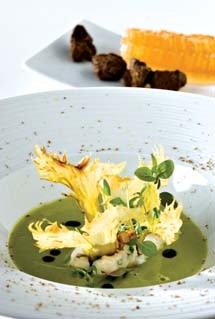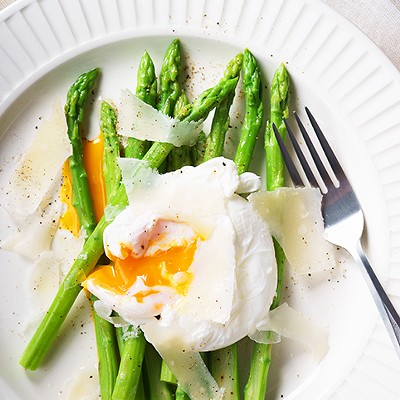Summer is a great time for vegetarians. It's also a great time for omnivores like me to entertain vegetarian friends and family. I've had fun using summer's bounty to make creations as sophisticated as any meat preparation and found inspiration from some top chefs who are using produce, grains, and legumes in innovative ways far beyond afterthought accompaniments to a hunk of protein.
It wasn't always that way. Not so long ago in the U.S., vegetarian dining options were limited to ethnic restaurants (far less common than they are today) and health-food cafés, most of which concentrated far more on their fare's healthiness than on its tastiness. In upscale restaurants, vegetarian options were more often than not limited to a "vegetable plate," usually a thoughtless collection of whatever sides were on hand.
The first U.S. restaurant to offer vegetarian fine
dining was San Francisco's Greens, which opened in 1979. According to
founding chef Deborah Madison, it was a classic case of "Your food is
so good, you should open a restaurant." Madison had been cooking for
the San Francisco Zen Center, which, as a Buddhist community, had a
vegetarian diet. According to a short autobiography at her
publisher's Web site, Madison says, "At that time, vegetarian
food couldn't have been further than anything mainstream. Its earnest
clumsiness drove fellow Zen students to the corner café where they
could eat fluffy pancakes with butter and syrup. My job was to tease this
counter-culture diet into one that was more familiar and appealing, yet
still remain vegetarian."
Madison obviously excelled at her job. Visitors to
the Zen Center spread the word about its delicious cuisine. When San
Francisco's historic Fort Mason was being reborn as a center for
not-for-profit organizations, developers wanted an on-site restaurant that
could fit that profile, and Greens was born. "Cooking sophisticated
and delicious food for a public that wasn't necessarily seeking out
vegetarian food was quite a challenge," says Madison. "For me
the most pleasing words from our customers were, 'I forgot there
wasn't any meat — it was so good!' "
Madison is no longer Greens' chef, but nearly 30 years later the restaurant is still going strong. I've eaten at Greens. It's upscale yet casual — a uniquely Californian combination — with beautiful wood fixtures handmade by Zen Center carpenters and equally beautiful views of the bay. The food is a pleasing combination of upscale and casual, too, in perfect harmony with the décor.
Closer to home, trailblazing chef Charlie Trotter
began offering a vegetarian tasting menu not long after his namesake
restaurant opened in 1987. The internationally renowned Trotter, who has
been given just about every honor and award the culinary world has to
offer, has no à la carte items on his menu. Patrons choose one of
two tasting menus: the Grand ($155) and the Vegetable ($130). According to Chicago magazine,
"The Vegetable menu astonishes even more [than the Grand], perhaps
with matcha green tea tapioca with spring peas and apples or morel
cannelloni with leek custard and roasted shallots."
Chicago chef Shawn McClain's Green Zebra restaurant is almost exclusively vegetarian, though the menu may include one or two fish or poultry dishes. The cuisine is also cutting-edge: On the current menu you can choose such dishes as roasted beets with wasabi gelée and cocoa-nib foam or foraged-mushroom popover with smoked cippolini onions. The Green Zebra's been wildly popular since its opening, four years ago.
None of these chefs is holier-than-thou about vegetarian food. In fact, they aren't vegetarians themselves. McClain has two other Chicago restaurants, one of which is a steakhouse. Even Madison isn't a vegetarian, though she eats meat sparingly.
They're simply excited about the myriad possibilities of vegetarian cooking and using their talents and skills to expand its horizons.
Contact Julianne Glatz at [email protected].
It's certainly possible to use just one kind of squash and one kind of cheese for these stuffed squashes, but using a variety of squashes makes for an especially attractive presentation and using two different cheese-and-herb mixtures makes them subtly, yet distinctively, different.
STUFFED SUMMER SQUASHES TWO-WAY
12 small summer squashes (no more than 6 inches long)
such as green or yellow zucchini, pattypan or yellow
crookneck squash, or small ball-shaped zucchini, either a
single type or a combination
1/2 cup extravirgin olive oil
2 cups finely chopped onion, not supersweet
1 tablespoon minced garlic (more or less to taste)
4 cups breadcrumbs made from stale homemade-type bread
3/4 cup sour cream
1 1/2 cup grated smoked Cheddar or another
smoked cheese such as Gouda
2 tablespoons chopped fresh sage
1 1/2 cup grated natural (not processed) Gruyère cheese
2 tablespoons chopped marjoram, rosemary,
or thyme (or a combination)
Freshly grated nutmeg to taste
Salt and freshly ground pepper to taste
Cut the squashes in half lengthwise (if you're using ball-shaped zucchini, cut a slice off the top about midway between its top and the equator). Using a melon baller or a spoon, hollow out the centers, leaving a shell at least 1/2 inch thick. Sprinkle the shells lightly with salt and turn them upside down on paper or lint-free towels to drain. Chop the centers and combine the chopped squash with the onion. In a large skillet, heat 2 tablespoons of the oil over high heat and add the centers and onion. Stir-fry until the vegetables are lightly browned and cooked through. Add the garlic and cook for another minute. In a large bowl, combine the contents of the skilletwith the breadcrumbs, sour cream, and salt and pepper.
If you are making both fillings, divide the mixture in two and place one half in a separate bowl. Mix 1 cup of the smoked cheese and the sage into one bowl and 1 cup of the Gruyère and the other herb(s) into the other. Add grated nutmeg to taste to the Gruyère mixture.
Preheat the oven to 400 degrees. With a paper towel, wipe the interiors of the shells dry. Lightly brush the squashes' exteriors with olive oil and place the squashes in a roasting pan. Fill the cavities with the stuffing, mounding it up slightly. Sprinkle the remaining cheese over the stuffing — be sure to match the cheese on top with that in the stuffing — and bake for 25 to 35 minutes or until the tops are browned and the squash is tender when pierced with a knife. Serves six as a main course and 12 as a side.
















